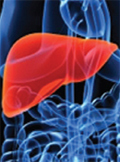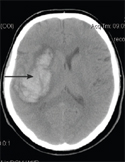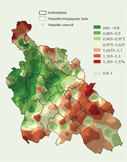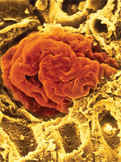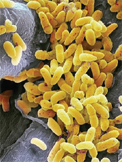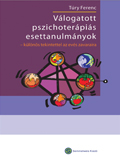The eLitMed.hu medical portal uses computer cookies for convenient operation. Detailed information can be found in the Cookie-policy.
Lege Artis Medicinae - 2010;20(11)
Content
[Diabetes mellitus and the liver]
[In the past years, the prevention of micro- and macrovascular complications has been the main target of diabetes treatment. Its unfavourable effects on the liver have been forgotten: the accelerated progression of the liver diseaeses and the increased risk of hepatocellular carcinoma. The multimetabolic syndrome leads to non-alcoholic fatty liver diseases (steatosis, steatohepatitis, cirrhosis). On he other hand some types of liver cirrhosis (for example the common alcoholic form) are worsening the insulin resistance, so they may due to a hepatogenous diabetes mellitus, that’s treatment is different and needs more regard, than type 2 diabetes.]
[Headache in everyday medical practice]
[Headache is one of the most common complaints in clinical practice. The International Headache Society’s current classification distinguishes two major categories of headache: primary and secondary (symptomatic) headache types. The former types, which account for the majority of headaches, are caused by a functional disorder in a structurally intact nervous system and are characterised by stereotypical attacks that resolve - in most cases - spontaneously after a certain period, the duration of which is characteristic for each headache type. The diagnosis of primary headaches is based on a detailed history of the attacks and negative results on a neurological examination. At the first presentation of the patient, it should be determined whether a potentially serious or life-threatening condition might be present, whether the type of the patient’s headache can be ascertained according to the IHS’s criteria, and what kind of examinations are needed to establish the correct diagnosis. A detailed history is the cornerstone of the diagnosis of primary headaches and it cannot be substituted by instrumental examinations. The use of imaging and other examination methods is necessary for the diagnosis of secondary headaches, but if the patient’s history and the results of the neurological investigation are fully consistent with a primary headache type, instrumental examinations are unlikely to provide any additional information. Although establishing the correct diagnosis is often time-consuming, it is necessary for the efficient treatment.]
[Treating breast cancer patients with fulvestrant - could it be more efficacious?]
[Fulvestrant, as an estrogen-receptor antagonist, effectively decreases the estrogen effect, which is a key factor in the development, growth and progression of the breast cancer. Its clinical advantage can appear even after several lines of unsuccessful chemo- or hormonal therapy. In our invasive ductal carcinoma cases, the clinical benefit was obvious over 40%. According to recent data using a higher dose better results can be obtained. The same is expected if the drug would be applied at an earlier stage of the disease.]
[Central nervous system hemorrhage in Wegener’s granulomatosis]
[In our case a 41-year-old man with following symptoms: non-productive coughing, fever, difficulty in breathing and weight loss was examined in February 2007, and on the basis of chest X-ray, CT and bronchoscopy, the possibility of neoplasm or tuberculosis cropped up. After the applied therapy (steroid, antibiotics, tuberculostatic drugs) the symptoms became more severe, i.e. hematuria and epistaxis were manifested. A tissue biopsy was carried out during bronchoscopy and the histological examination revealed granulomatous reaction. Meanwhile, the presence of c-ANCA was proved, and Wegener’s granulomatosis (WG) was diagnosed. In March 2007, sudden somnolence and left side hemiplegia developed, and a large haemorrhage was recognised on CT scan in the right fronto-temporal region, with regard to the haemorrhage, the patient had to undergo a neurosurgical operation. We started to treat him in April 2007 by intravenous steroid and 600 mg of cyclophosphamide (Cyc), and he regained the ability to walk again. In October 2007, the Cyc treatment was terminated, and we administered a maintenance therapy with methotrexat. During the regular medical check-up, a chest X-ray indicated a second attack in March 2008, which was confirmed by the chest CT, the clinical symptoms, increased anti-PR3 levels and c-ANCA positivity as well. The flair of the disease was established. Consequently, in April 2008 we decided on plasmapheresis therapy synchronised with Cyc. After that, we started an azathioprine maintenance therapy and he got rid of all the activation symptoms. We can say that with the adequate therapy started in good time and with the regular medical check up of the patient a good result can be achieved. It is true even in the case of WG disease associated by severe complication, for example central nervous hemorrhage.]
[Trends of mortality amenable to health care in Hungary and in the Central Region, 1996-2006]
[INTRODUCTION - Despite of the decreasing trend of amenable mortality it is a significant contributor to social and economic loss due to premature death. This paper assesses the trends of amenable mortality over time, its contribution to the years of potential life lost (YPLL), furthermore reveals the spatial inequalities of the amenable mortality in the central region in relation to socioeconomic status and number of the inhabitants of municipalities. METHODS - This study describes the trend of the years of potential life lost due to amenable mortality during the period 1996-2006 in Hungary, in Pest county and in Budapest. The spatial epidemiological analysis of the amenable mortality was carried out by using smoothed indirectly standardised mortality ratio calculated by full hierarchical Bayesian methods at municipality level. The association between the spatial distribution of amenable mortality and socio-economic status was assessed by using a “Deprivation Index” elaborated by the authors. RESULTS - The years of potential life lost of males were 7207 (per 100 000) and respectively for females these value was 3870 (per 100 000) in Hungary in 2006. The amenable mortality is a significant contributor to years of potential life lost despite its decreasing trend. The amenable mortality accounted for approximately one third of the males’ and the females’ years of potential life lost. The risk of amenable mortality is higher in the less populated areas and the less-favoured socioeconomic situation coexists with high mortality risk. CONCLUSION - Approximately in average 32 000 persons died due to amenable mortality per year during the investigation period in Hungary. The results of the study provide essential information to the local policy-makers, and managing health professionals. The results can be used principally to inform planning healthcare development programs.]
[Renal care - possibilities of complex organ protection]
[The authors analyse data of the last ten years of renal care. According to the principles of care they prefer to have contact at least once to all patients with an estimated clearance less than 60 ml/min, and on a regular basis to those with less than 30 ml/min. Their fundamental ambition is to develop the most favourable therapy for the patients together with general practitioners and with representatives of other specialities. The most important aim is to reduce cardio-renal morbidity and mortality. Early detection and effective treatment of target organ damage are the tools for this. It is clear from their previous work that it was not successful in the first period of care (2000-2005) especially in patients with diabetic nephropathy. Before the initiation of renal replacement therapy only half of the patients have been seen by a nephrologist. One-year-mortality after initiating dialysis was significant among patients who did not receive such care. Their medication was also not up-to-date. Through regular continuing medical education for general practitioners and in close collaboration with diabetologist colleagues the number of patients taken care of has doubled. Furthermore, the proportion of patients with hypertension or diabetes as an underlying disease among the patients receiving renal care increased to 68%. These findings may contribute to that their patients receive effective treatment taking the actual therapeutic recommendations into account. Hopefully it will be apparent in the hard end-points at the time of the analysis of the second period.]
[In vitro efficiency of doripenem, a new carbapenem against Gram-negative, aerob, problem bacteria - Prospective, multicentric, Hungarian study]
[INTRODUCTION - Doripenem is a new carbapenem derivative, it’s chemical structure is similar to that of meropenem (substitution of one sulfamoxil-aminomethyl chain for the dimethylcarboxy chain) and has one 1-beta-methyl chain which provides resistance to dyhidropeptidase-I enzyme produced by the human kidney. It has a broad-spectrum of activity against multiresistant Gram-negative bacilli such as ESBL-producing Enterobacteriaceae and non-fermentative Gramnegativ bacilli including some strains of Pseudomonas aeruginosa that are resistant to other carbapenems. In 2010 between February and June a multi-centre comparative study was carried out including 5 Hungarian laboratories to investigate the in vitro activity of doripenem. MATERIAL AND METHODS - 1000 fresh, clinically relevant isolates were included both ESBLproducing and non-producing Enterobacteriaceae strains and resistant and multi-resistant Pseudomonas aeruginosa and Acinetobacter strains. The activity of doripenem and the comparator antibiotics (other carbapenems) were tested by the disc diffusion method. In the case of intermediate resistant strains the MIC of doripenem was also determined by the E-test methodology. RESULTS - All but one isolate belonging to the Enterobacteriaceae (592 isolates) were fully susceptible to doripenem. The only Enterobacter strain which proved to be intermediately susceptible to doripenem by the disc diffusion method was also found to be susceptible showing an MIC of 0.125 μg/ml. In the case of the 163 Pseudomonas aeruginosa and the 121 Acinetobacter spp isolates doripenem was the most active carbapenem compared with imipenem and meropenem (78.6% and 50.5% for doripenem versus 67.5% and 42.0% for imipenem and 68.7% and 30.2% for meropenem, respectively). CONCLUSION - According to our multi-centre study doripenem was highly active against both the ESBL-producing and ESBL-non-producing Enterobacteriaceae strains and against a great part of the Pseudomonas and Acinetobacter isolates often involved in nosocomial infections.]
1.
Clinical Neuroscience
Is there any difference in mortality rates of atrial fibrillation detected before or after ischemic stroke?2.
Clinical Neuroscience
Factors influencing the level of stigma in Parkinson’s disease in western Turkey3.
Clinical Neuroscience
Neuropathic pain and mood disorders in earthquake survivors with peripheral nerve injuries4.
Journal of Nursing Theory and Practice
[Correlations of Sarcopenia, Frailty, Falls and Social Isolation – A Literature Review in the Light of Swedish Statistics]5.
Clinical Neuroscience
[Comparison of pain intensity measurements among patients with low-back pain]1.
Clinical Neuroscience Proceedings
[A Magyar Stroke Társaság XVIII. Kongresszusa és a Magyar Neuroszonológiai Társaság XV. Konferenciája. Absztraktfüzet]2.
3.
Journal of Nursing Theory and Practice
[A selection of the entries submitted to the literary contest "Honorable mission: the joys and challenges of our profession" ]4.
Journal of Nursing Theory and Practice
[End of Life and Palliative Care of Newborns in the Nursing Context]5.
Journal of Nursing Theory and Practice
[Aspects of Occupational Health Nursing for Incurable Patients ]



